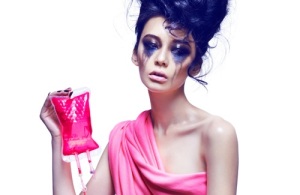Ethical Fashion: Introduction to a Three-Week Series!
You can see the full post, here: http://listengirlfriends.wordpress.com/2012/12/03/ethical-fashion-i...
This past summer, I decided it would be a good idea to clean out my apartment while I was moving to another place. It felt really good to 'detox,' so to speak, and I relished throwing out old advent calendars in the back of my storage closet, jewelry that was either falling apart or just kind of tacky (do you really need a huge gold peacock ring Nadia, do you?), and clothing that I wasn't really feeling anymore. As I threw out everything with fervor, something hit me (I think when I picked up a pair of feather earrings that I bought before I began to think seriously about cultural appropriation). I realized that everything I was tossing out was mass-produced. And that when I came across a necklace given to me by my mother, or the Zuni ring that was made by an actual Zuni woman (instead of a 'Native-inspired' design made by factory workers abroad), or the Tagua nut necklace that I bought from an artisan in Puerto Rico whose face I still remember, I just couldn't let it go. Not only did I consider these items art in the way that they had been lovingly hand-crafted, but I had a personal connection with the people who had made them or given them to me. It was easier for me to toss out the shirt I got from Urban Outfitters or the earrings I bought years ago at Forever 21, because I had no knowledge of who made them. They meant little to me. I didn't value the work put into these items as much because I knew nothing about it, or the people behind it.
When I wrote my first post on why I blog about fashion, I revealed my complex feelings about the industry, and I have started to document its many contradictions which I find to be both fascinating and so unbelievably challenging. Despite my appreciation for fashion as a mode of expression, I have always been disillusioned with the labor exploitation behind the glamorous façade of the industry. Even though I had been involved in anti-sweatshop campaigns before, and had enjoyed vintage and artisan made products, I still found myself buying into the status quo of retail that encourages mainstream consumption of 'fast fashion' (or buying more clothes at a discount) on the one end, and the idealization of unattainable high couture on the other. Why was I bragging about the great bargain I had scored at the designer discount site, knowing that by doing so, I was also discounting the labor and people behind it? Or drooling over the latest purse Blair Waldorf carried on Gossip Girl, despite being aware that high couture is often a means by which the show reinforces class divisions? Why, girlfriends, wasn't I connecting the dots?

- The unglamorous side to fashion: A child jumps on leather luxury waste products as she plays in a tannery in Dhaka, Bangladesh (Article here)
The revelation I had this past June standing in my room staring at all of that stuff (and given the total trauma of moving that mountain of possessions, I did wonder did I possess them, or did they posses me?!) was what I would mark as a significant moment in how this movement of sustainability started to truly penetrate my consciousness. Sustainable fashion implies that the product has been made with thought and consideration of its environmental and social impact, and in the following months, as I read about the textile fire in Pakistan that killed more than three hundred people, or the 'apparel trend' report that revealed how companies like Wal-Mart and Forever 21 are ignoring claims of child and forced labor from their workers, or how exporting this cheap labor means a loss of industries and jobs in the U.S, I felt a need to share this information with others. When I read Elizabeth Cline's book Overdressed, I was shocked to learn that garment workers overseas are earning just one percent of the retail price of the clothing they produce, and that the wages of garment workers could be easily doubled or tripled with little or no increase for American consumers. I wanted to understand if Nike could afford to double its pay to its thousands of shoe factory employees without raising any of their consumer prices, why weren't they doing it?
Although I had always been aware of the exploitative labor behind the clothes we wear, I had never really considered the harmful environmental impact of the conventional textile industry's manufacturing process. And then, once I learned about the cancer-causing chemicals that are found in the very fabrics we wear, I knew I needed to connect the dots not just between culture and labor, but between environmental sustainability and cultural economies. Jean Cocteau once noted that "style is a simple way of saying complicated things," and indeed in today's world, the clothes we wear should not be dismissed as merely frivolous things, but as signifiers of the truly deep social, environmental, and economic stryctures of unconscious consumerism.
For the last few weeks, I have been interviewing major industry players, from garment workers to activists to designers, who are making sustainability their focus. I will be incorporating these interviews in a three-week series that I hope will expose the contradictions and lack of transparency in the industry, as well as the ways in which we can start to connect the dots between all of these different concerns and issues within this complex industry. This series will feature:
- Week One: An interview with Marci Zaroff, who coined the term ‘Eco Fashion’ and has been instrumental in drafting Fair Trade and Organic textile standards for the industry in the U.S. In that post, I will provide some basic information on the environmental impact of the textile industry, fair labor practices and why an Indian cotton farmer is committing suicide every half hour. I will also be asking Marci to help us respond to questions and critiques about sustainability. I will then be interviewing Callie Brauel of A Ban Against Neglect (ABAN), a non-profit that empowers street girls in Ghana while helping to clean up the environment. And since I myself know that navigating through all of these different components of the industry can be overwhelming, I will help to pinpoint which companies are truly committed to ethical labor and environmental practices, and which ones are just using social responsibility as a way to attract more people to their product. Want resources on where to get information on ethical fashion and sustainability in general? Don't worry peeps, girlfriend will be hooking you up!
- Week Two: During this week, I will focus on the people behind the clothes we make. I will be interviewing Rachel Taber from the textile company Alta Gracia, which pays its workers a living wage (while maintaining very affordable prices) and is consistently ranked as having the best monitoring practices in the industry. I will then follow this up with an interview by a garment worker from Alta Gracia who used to work in a sweatshop. Maritza Vargas, who is from the Dominican Republic, will be telling all - about her life as a worker in a sweatshop factory, about the labor union struggles, and the truth behind the 'Fair Labor Association's' monitoring practices (spoiler alert: the truth isn't always pretty!). Towards the end of the week we will turn to a non-profit called MamAfrica that is based in the Democratic Republic of Congo. The co-founders, Aline Malekera and Ashley Nemiro, created the organization to provide holistic services for refugee women in the town of Bukavu, and are incorporating the art of sewing in their mission to empower women both economically and socially. I will also be answering reader questions (umm...so excited!) about critiques of fair trade as well as how to go about different sustainable practices, like DIY (do it yourself) clothing, thrift shopping, and/or just buying less .
- Week Three: Here we will discuss the connection between fashion and art, and question whether the artisan/sustainable movement brings the 'art' back to a textile landscape increasingly known for its homogenous and cheaply produced products. This week will also highlight different fashion/jewelry designers who make it a point to incorporate sustainable practices in their lines while empowering marginalized communities both in the U.S. and abroad. Interviews will include Marissa Heyl from the line Symbology, couture designer Kahindo Mateene from the line Modahnik, and Jessica Metcalfe, whose boutique Beyond Buckskin exclusively features Native-made fashions.
Oh, and I just might be throwing in giveaways of socially conscious items, and a post on haute couture in the show Gossip Girl - cause it's all about the extras that gets thrown in your gift bag, right? ;)
Basically, the reason why I began this blog in the first place was to start conversations, and my purpose for this three-week series is not to preach perfection, but to encourage conscious choices through increased awareness of issues related to sustainability, specifically in regards to the garment industry. I truly believe that when we don’t know where our clothes are made, than we lose that sense of community and human connection that is so important. I hope to highlight the importance of handmade products that help to personalize the process of production and revive the relationship between those who make the clothes and those who purchase them. My intention is not to dismiss fashion (never!), but to envision improvement by examining where culture and labor meet, and the effect that this has mostly on women. My hope is that by using fashion as my ‘example,’ I also can help create awareness on other related issues, like the environment, suspect practices in certifications and labeling, and labor.
So, let's do this girlfriends!
Related Posts:
Welcome to
Ethical Fashion SOURCE Network
© 2025 Created by Ethical Fashion Forum.
Powered by
![]()

You need to be a member of Ethical Fashion SOURCE Network to add comments!
Join Ethical Fashion SOURCE Network